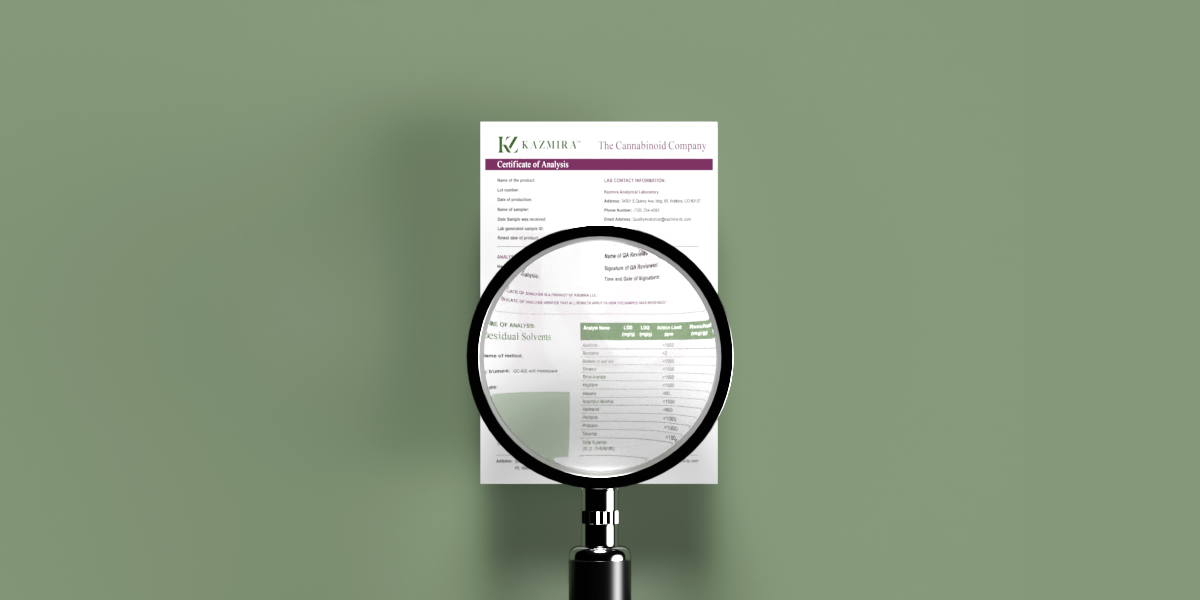How to Read a Certificate of Analysis (COA)?
What is a certificate of analysis?
A certificate of analysis (COA) is a lab report on the chemical make-up (e.g., contents) of a product. In the context of Industrial Hemp extracts, the COA reports on the cannabinoid, terpene, and contaminant profile of CBD products. COA’s are used to verify that the contents of the product are matched to how it is advertised. These reports are important for verifying that hemp extracts have less than 0.3% THC by weight, as determined by the definition of Industrial Hemp in the law. At Kazmira, THC-Free products are supported by COA’s such as the one shown below, which indicate ‘non-detect’ levels of THC. Also, tests are carried out to check for dangerous compounds such as heavy metals or pesticides and reported in the certificate to ensure the safety of the consumers.
Why are COAs important?
A study conducted in 2017 found that almost 70% of online CBD products are mislabeled, either having substantially more or less CBD than advertised. For nutraceutical applications, knowing the exact potency and ingredients is extremely important. For example, manufacturers could claim a CBD product contains no THC, or claim a certain potency in their product, but since there is little oversight, the opportunity to “fudge the numbers” is compounded. This could be a major issue for people who are choosing products without THC in order to avoid its psychoactive side effects or pass a drug test because of a job. In an unregulated industry, with new CBD companies popping up everywhere, it is difficult for customers to know exactly what they are paying for.
Labeling alone is not reliable, especially when products are sold online to customers who do not fully understand the ins and outs of the industry. This is the reason COA’s are standard practice for reliable, law-abiding CBD manufacturers. They create transparency for consumers as well as regulators to clearly identify exactly what is and is not inside a given hemp extract.
How do I find the COA for my CBD product?
There are a few ways to find COAs. Most companies will include them on their website, or provide them to customers upon request. Make sure they are up to date and match the batch number listed on your product.
Indiana, Texas, Utah, and Florida have passed state laws that require QR codes on all CBD products. Although other states have not yet passed similar laws, most CBD companies are transitioning to include QR codes on their packaging to increase transparency and make it easy for customers to find this information.
Customers can use their phones to scan the code on the package and link directly to the COA specific to the product that the code is printed on.
How do I read a COA?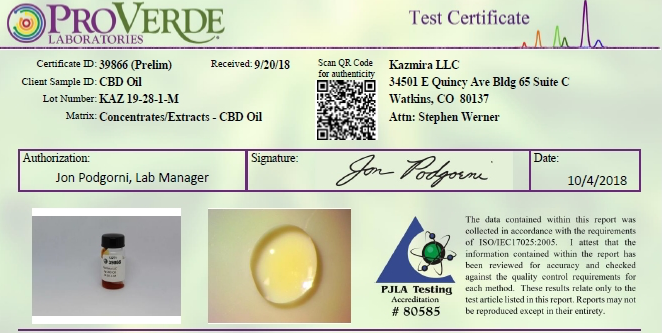
The first thing you want to check on a COA is that the company who performed the lab test is not the same company who is selling the product. This is called a ‘third party’ test and it is to ensure transparency in the results. If it was only tested by the company selling the product, there could be bias in the report.
*This description is specific to the example COA provided by this third-party lab. COAs may vary from lab to lab, but all of the elements described should be present, regardless of format.
On the top left, there is information to identify the sample and batch which it came from. On the top right, the address and contact information of the company selling the product is listed. The QR code in the top center can be scanned by anyone to verify the authenticity of the report. It links to the lab that performed the analysis so consumers can cross check to make sure the COA was not fabricated.
Cannabinoid Profile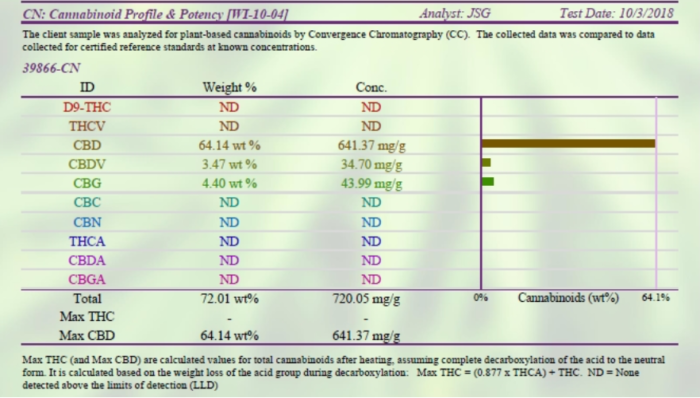
The bottom half of the first page shows the cannabinoid profile of the sample, listing the cannabinoids which were detected as well as their concentration. This is probably the most important section of the COA because it tells consumers exactly which cannabinoids are present and at what potency. The ID column of the chart indicates which cannabinoids were tested for. D9-THC is the psychoactive component which must be lower than .3 weight % (middle column) in order for it to be legal.
‘ND’ stands for ‘non-detect’ meaning there was such a miniscule amount, if any, in the sample that the laboratory instruments could not detect it. Essentially, this means it is not present in the product. All Kazmira products which are labeled THC-Free are tested to have ND levels of THC. This specific report is analyzing a CBD oil said to have no THC, which is reflected in this table.
CBD, CBDV, and CBG were detected in the analysis and their concentration is reported in milligrams per gram of the product. This ‘Conc.’ column is the potency of the tested CBD oil, which should be compared to the CBD concentrations advertised on the label of the product. On the right of the chart is a bar graph corresponding to the relative amounts of the various cannabinoids in the product sample.
THC-Free broad spectrum hemp oils should have CBD, other cannabinoids such as CBG or CBN, but non-detect levels of THC. Full spectrum hemp extracts should have many cannabinoids including D9-THC, as long as the THC weight % is below 0.3%.
Heavy Metal Analysis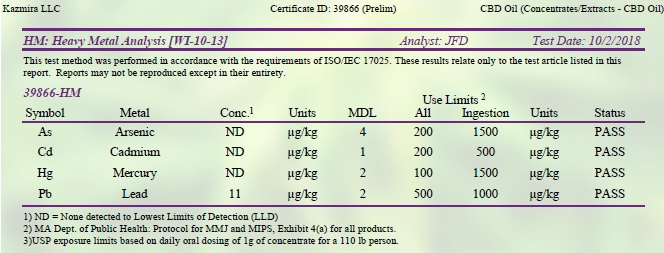
The heavy metal analysis chart indicates which metals were tested for with the chemical symbol and name. ‘Conc.’ is the concentration of the metal measured in the sample. ‘Units’ refers to the measurement size, in this case micrograms per kilogram (1,000,000,000 micrograms in 1 kilogram).
MDL is the lower limit of detection for the lab instruments. ‘Use Limits’, the most important of which being ‘Ingestion’, is the amount determined by the state Department of Public Health and U.S. Pharmacopeia that is safe to ingest per day. In the case of this report, lead is the only metal detected and it is well below the allowed limit. 11 micrograms per kilogram were detected while the standardized safety limit is 1000.
Pesticide Analysis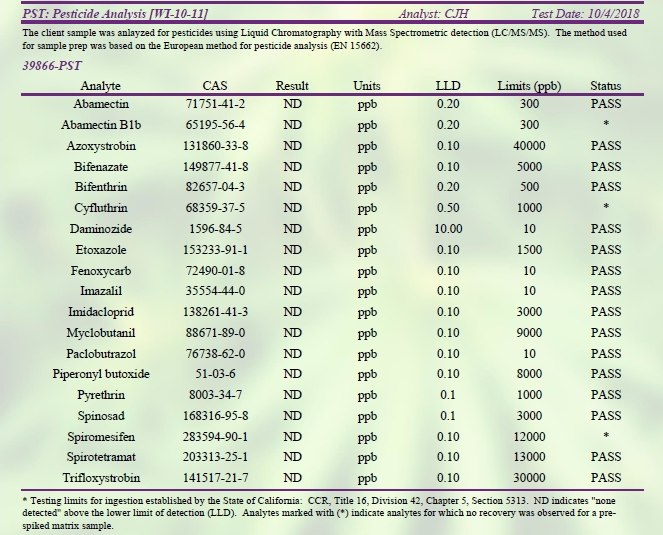
Another report in the COA is the pesticide analysis, which lists a number of common pesticides tested for in the sample. The unit in this case is ‘ppb’ or parts per billion. LLD is the “lower limit of detection” based on each specific pesticide, and the ‘Limits’ column is the maximum amount allowed for consumption based on safety regulations established in the State of California (these values may vary slightly depending on the specific state or federal guidelines identified in the report). The ‘Status’ column indicates PASS if the sample is under the legal limit or NO PASS if the levels are above the limit. In this report, no pesticides were detected.
Terpene Profile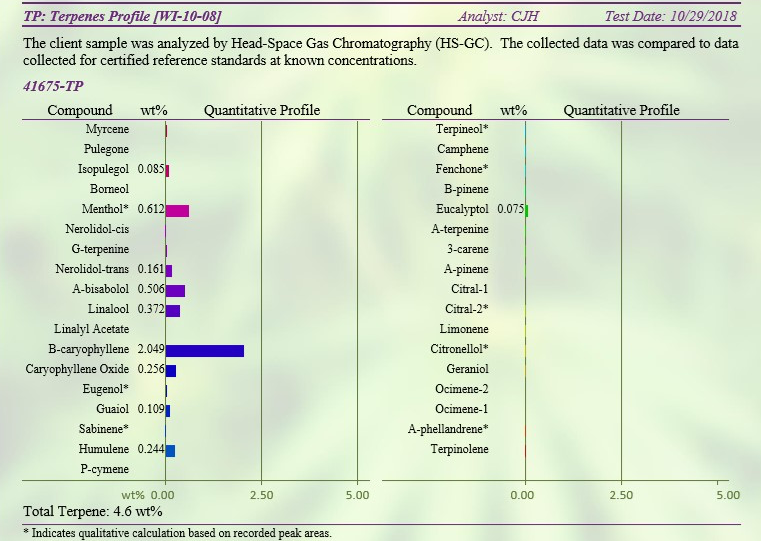
The terpene profile analysis shows which terpenes were detected in the sample and the relative amount of each by weight percent. Terpenes are what give hemp products their unique flavors and aromas. The variation in kind and abundance can give consumers information on how it may smell or taste. More information on terpenes and their role in hemp can be found in our blog ‘What are Terpenes?’
Don’t Pay Without the COA
In an industry that is quickly expanding with limited regulation, it is extremely important that as a consumer, you know exactly what you are purchasing. Certificates of analysis provide transparency and assurance to consumers so they can be confident in what they are buying.
Although COAs vary in appearance depending on the lab, the basic information presented in this article should be present on any third party COA. Dates and product batch numbers should be listed so consumers can make sure that the report is up to date and specific to the batch that their product is from. The cannabinoid profile should match the product description, including the type of extract (broad spectrum, full spectrum, etc.) and potency of the product.
Heavy metal and pesticide analysis can be used to ensure that the hemp was grown safely and its extract is safe to consume. Companies which do not provide up to date certificates of analysis should be avoided. COA fraud also exists in the industry and precautions should be taken in order to make sure your COA has not been fabricated. For more information on how to verify the authenticity of a COA, check out our blog, “Can I Trust Certificates of Analysis?“

